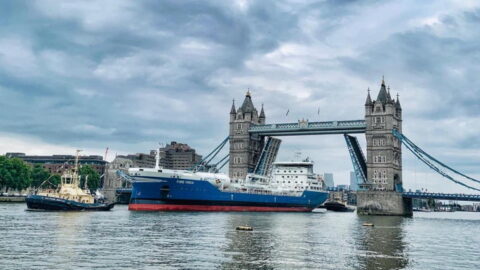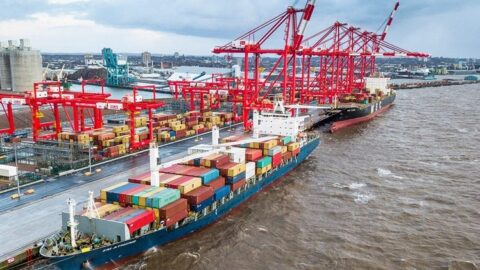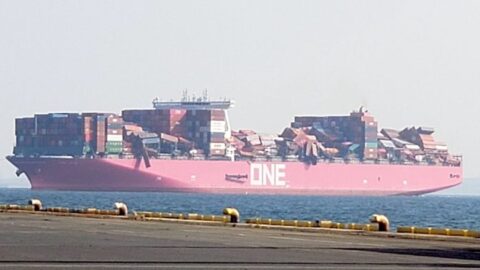El incendio en el portaautomóviles Fremantle Highway en el Mar del Norte es solo el último de una larga y creciente lista de incendios que involucran vehículos en embarcaciones roll-on/roll-off (RoRo).
Como hemos informado, el barco con bandera de Panamá se incendió justo antes de la medianoche del martes después de partir de Bremerhaven, Alemania, en un viaje a Port Said, Egipto. Todos los miembros de la tripulación abandonaron el barco o fueron rescatados en helicóptero. Lamentablemente, un miembro de la tripulación ha muerto y varios han sufrido heridas.
Inicialmente se informó que el barco transportaba 2.857 vehículos, incluidos 25 vehículos eléctricos. Sin embargo, el fletador del barco, “K” Line, ahora ha actualizado esas cifras a 3.783 unidades totales y 498 vehículos eléctricos a bordo, todos los cuales son nuevos.
A partir de ahora se desconoce la causa del incendio, pero hay informes de que el incendio “comenzó en la batería de un automóvil eléctrico”, según una grabación de una transmisión de radio publicada por la emisora holandesa RTL. A medida que la respuesta continúa, el incidente recuerda varios incendios anteriores que involucraron vehículos estibados en barcos de carga rodada en los últimos años. Aquí hay un vistazo a algunos de esos incidentes:
Grande Costa D’Avorio

El Grande Costa D’Avorio, una combinación de roll-on/roll-off (ConRo), de bandera italiana, se incendió el 5 de julio de 2023 mientras cargaba vehículos usados para la exportación en Port Newark, Nueva Jersey. Trágicamente, dos bomberos murieron en la respuesta inicial y otros seis resultaron heridos. El fuego continuó ardiendo durante unos seis días antes de que se extinguiera.
El operador del barco, Grimaldi Deep Sea, parte de Grimaldi Group, con sede en Italia, dijo que el barco transportaba alrededor de 1.200 vehículos y 157 contenedores, pero supuestamente no había vehículos eléctricos o carga peligrosa a bordo. La investigación sobre las causas fundamentales y los factores contribuyentes está siendo dirigida por la Guardia Costera de los Estados Unidos junto con la Junta Nacional de Seguridad del Transporte (NTSB).
Felicity Ace
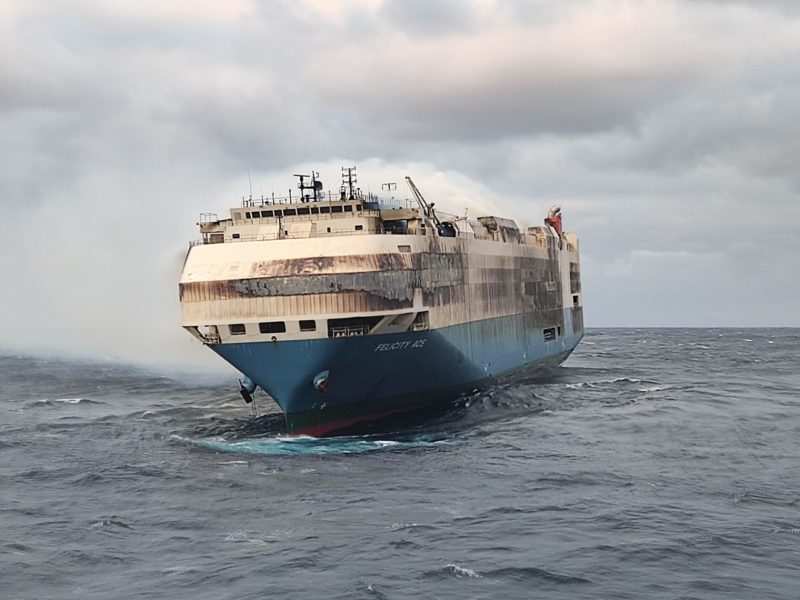
The Panama-flagged Felicity Ace, operated by Mitsui O.S.K. Lines (MOL), caught fire on February 16, approximately 90 nautical miles southwest of the Azores as the ship was underway from Embden, Germany to the U.S. East Coast. All 22 crew members abandoned ship safely.
The ship was reportedly carrying some 4,000 vehicles, including some electric vehicles and luxury brands like Porsches, Bentleys, and Lamborghinis, along with VW and Audis. The fire continued to burned until the ship sank about two weeks later on March 1, 2022. The Panama Maritime Authority’s investigation report into the incident was submitted to the IMO in May but is not yet publicly available.
Höegh Xiamen
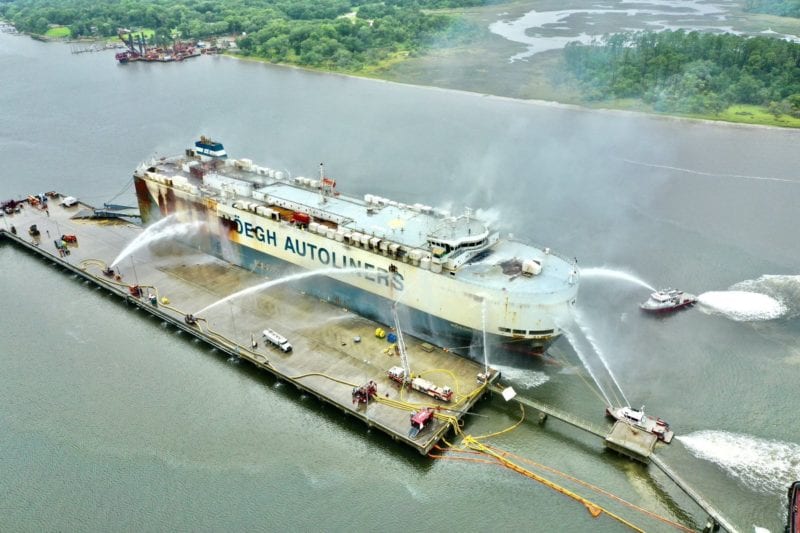
Grimaldi’s Höegh Xiamen was carrying 2,420 used vehicles on board when it caught fire in in Jacksonville, Florida, on June 4, 2020. Nine firefighters were injured in the response and the fire took over a week to extinguish, resulting in the total loss of the vessel and cargo. The NTSB investigation revealed the fire started due to an electrical fault from an improperly disconnected battery in a used vehicle.
The NTSB determined the probable cause of the fire was ineffective oversight of longshoremen by Grimaldi Deep Sea, the ship’s charterer, and SSA Atlantic, Grimaldi’s contractor for stevedores, who failed to identify that Grimaldi’s own vehicle battery securement procedures were not being followed. The crew’s failure to reactivate the fire detection system after loading was completed and the Master’s decision to delay the release of the carbon dioxide fixed fire extinguishing system contributed to the extent of the fire in the car carrier.
“The transportation of used vehicles, such as those that were loaded on vessels like the Höegh Xiamen, is currently excepted from Hazardous Materials Regulations when a vessel has a stowage area specifically designed and approved for carrying vehicles,” NTSB said in the report. “We found that used vehicles are often damaged and present an elevated risk of fire. We believe that greater inspection, oversight, and enforcement are needed to reduce this risk.”
As the NTSB’s report pointed out, Grimaldi had developed a battery disconnect procedure for its vessels in response to previous fires. However, the Coast Guard’s post-accident examination of a sample of 59 vehicles from Höegh Xiamen found not a single battery that was secured in accordance with the disconnect procedure, even though the procedure was in place at the time of the accident.
Interestingly, the NTSB report into the Höegh Xiamen fire highlighted five similar accidents since 2015, including a 2019 fire aboard another Grimaldi ship, the Grande Europa.
Grande Europa
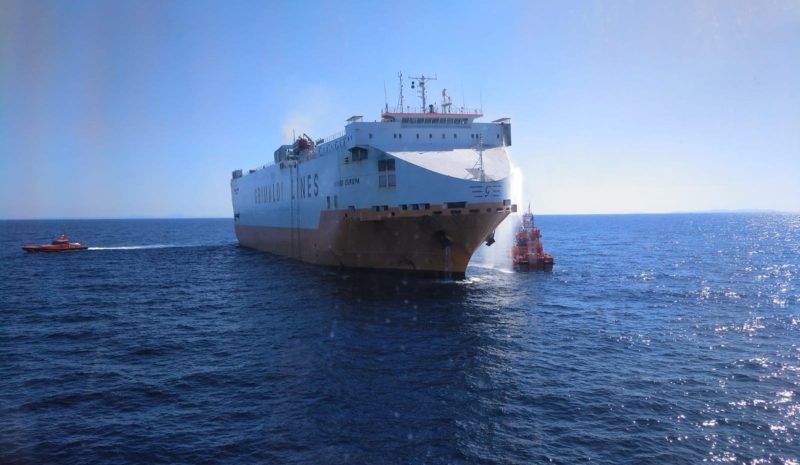
The fire on board the Grimaldi vessel Grande Europa started on May 15, 2019, while the vessel was underway about 25 miles off Palma de Mallorca, Spain. Its cargo consisted of 1,687 vehicles, including cars, vans, trucks, and excavators, the majority of which were new. There were also 49 containers containing mainly food products.
The initial fire started on vehicle deck 3, but was extinguished by the ship’s crew in about 45 minutes. A few hours later, however, a second fire started on a separate deck and spread from there. Grimaldi’s preliminary investigation into the incident suggested that the two fires started from two different new vehicles stowed on board and then spread to the other vehicles nearby.
The day after the incident, Grimaldi issued a press release calling for more controls on car batteries, as well as the total prohibition of personal effects in second-hand vehicles on roll-on/roll-off vessels. They also called more stringent controls and regulations on not only rolling cargo, also containers.
Grande America
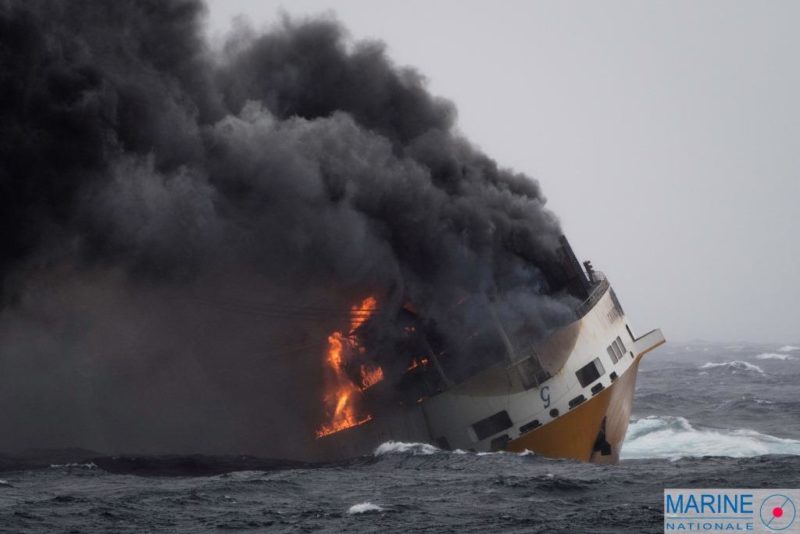
The Grimaldi ConRo Grande America sank in the Bay of Biscay back on March 12, 2019, two days a cargo fire broke out on a voyage from Hamburg, Germany to Casablanca, Morocco. The ship was carrying around 860 tons of dangerous goods and about 2,100 new and used vehicles.
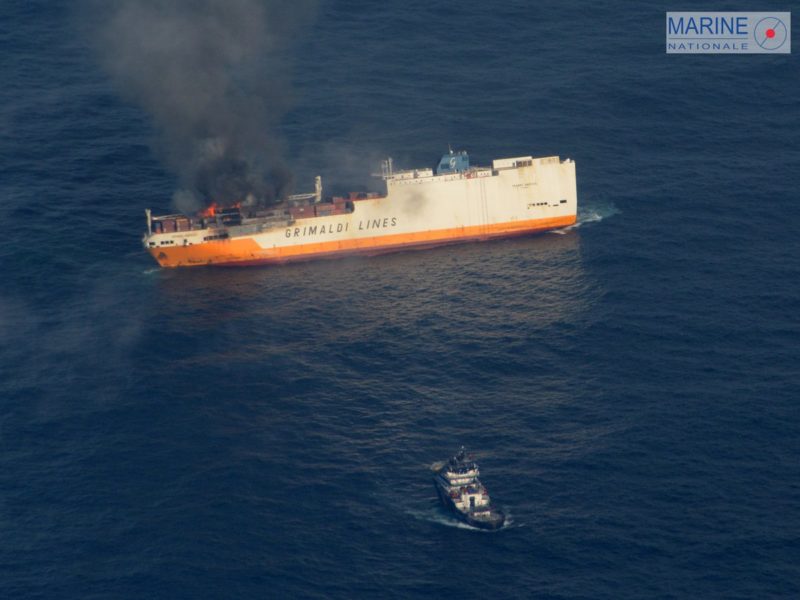
Similar to the Felicity Ace, Italian authorities have submitted final reports to the IMO, but they are not yet publicly available. However, the NTSB says investigators were unable to determine a definite origin and cause of the fire, or fires, other than that fire teams found sparks coming from a truck on a vehicle deck. The fire was fought with dry chemical extinguishers, and later the vessel’s fixed CO2 system. The ship eventually lost power, and the fire spread to or started separately in a cargo container.
The crew abandoned ship and were rescued without any injuries. The vessel sank in about 13,000 feet of water and its VDR was never recovered.
Honor
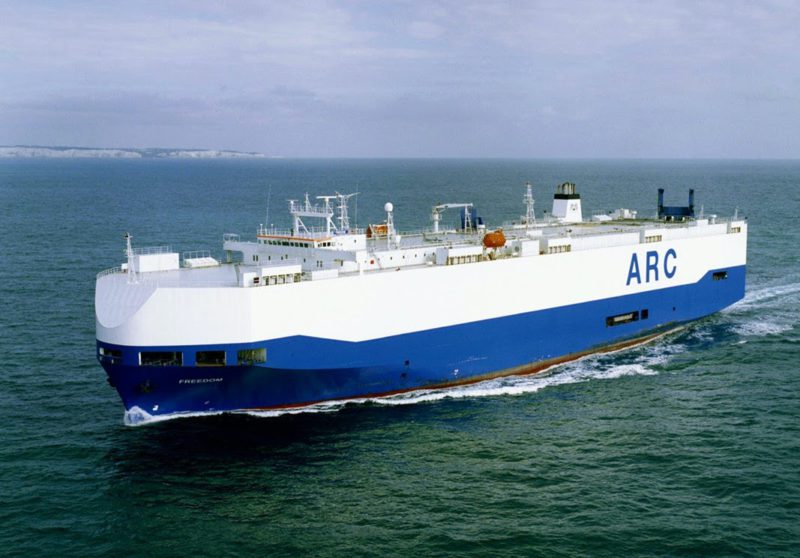
On February 24, 2017, the 623-foot-long US-flagged car carrier Honor, operated by U.S.-based ARC, was en route from Southampton, England, to Baltimore, Maryland, when a fire broke out in the upper vehicle deck. The fire was extinguished by the crew using the vessel’s fixed CO2 firefighting system. The accident resulted in extensive damage to the Honor’s hold as well as its cargo of about 5,000 vehicles. The Honor operated between various ports in the U.S and Europe, carrying new production vehicles, military vehicles, and personally owned used vehicles for military and government personnel, as well as household goods shipments.
The NTSB determined that the probable cause of the fire was a fault in the starter motor solenoid in one of the personally owned vehicles being transported in the vessel’s cargo space. One injury was attributed to the firefighting efforts.
Courage
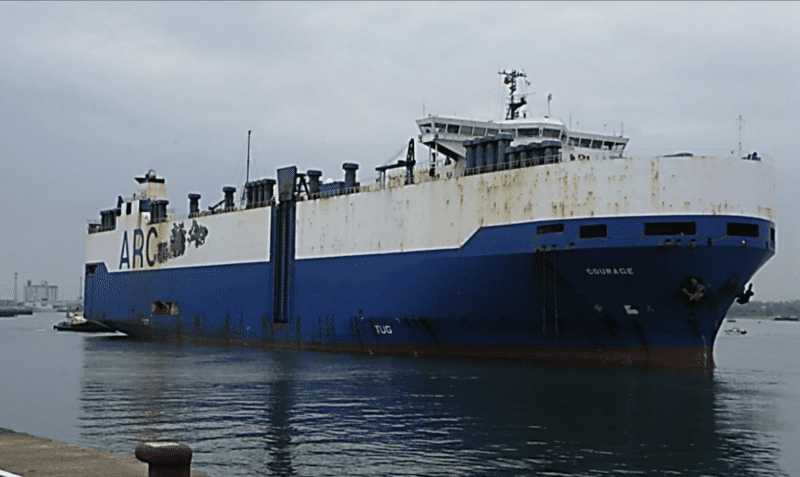
El 2 de junio de 2015, otro transportista de automóviles ARC, Courage, sufrió un incendio en su bodega de carga durante un viaje desde Bremerhaven, Alemania, a Southampton, Reino Unido. El buque de bandera estadounidense transportaba nuevos vehículos de producción (Mercedes-Benz y BMW), vehículos militares, vehículos usados de propiedad personal para personal militar y gubernamental, y envíos de artículos para el hogar. El accidente resultó en daños extensos a la bodega de carga del buque, así como a los vehículos y artículos para el hogar. Como resultado del daño, estimado en $ 40 millones en total, los propietarios del buque desguazaron el buque.
La NTSB determinó que la causa probable del incendio fue el arco eléctrico en el módulo del sistema de frenado automático de un vehículo llevado a bordo.
Menciones notables: Arc Independence y Höegh Transporter
En 2020, la Guardia Costera de los Estados Unidos investigó dos incendios de portaautomóviles además del incendio de Höegh Xiamen. El Arc Independence, un buque con bandera estadounidense, experimentó un incendio de carga mientras estaba en marcha el 30 de agosto de 2020, a unas 180 millas de la costa de Jacksonville. El incendio fue detectado por el sistema de detección del barco y contenido en un solo vehículo gracias a los esfuerzos de la tripulación utilizando extintores de incendios.
Unos meses más tarde, el 17 de noviembre de 2020, el Höegh Transporter de bandera noruega experimentó un incendio mientras fumigaba en el muelle 20 de Blount Island en Jacksonville antes de zarpar. Se informó que el incendio comenzó en un vehículo nuevo después de que se completaron las operaciones de carga. El fuego se extinguió sin más daños.
Conclusión
Si bien es difícil sacar conclusiones sobre el incendio de Fremantle Highway y otros de incidentes anteriores, una mirada retrospectiva a incidentes similares proporciona una idea y antecedentes sobre los peligros asociados con el transporte de vehículos nuevos y usados en barcos de carga rodada. Con la creciente popularidad de los vehículos eléctricos, será interesante ver cómo o si las reglas y regulaciones evolucionan para enfrentar los nuevos desafíos asociados con el transporte por barco.
gCaptain

